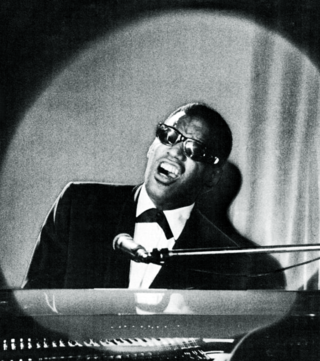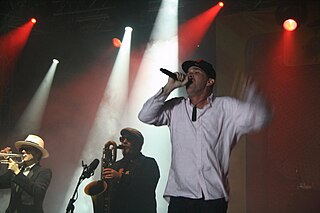Related Research Articles
"World music" is an English phrase for styles of music from non-Western countries, including quasi-traditional, intercultural, and traditional music. World music's broad nature and elasticity as a musical category pose obstacles to a universal definition, but its ethic of interest in the culturally exotic is encapsulated in Roots magazine's description of the genre as "local music from out there".

Ambient music is a genre of music that emphasizes tone and atmosphere over traditional musical structure or rhythm. It may lack net composition, beat, or structured melody. It uses textural layers of sound that can reward both passive and active listening and encourage a sense of calm or contemplation. The genre is said to evoke an "atmospheric", "visual", or "unobtrusive" quality. Nature soundscapes may be included, and the sounds of acoustic instruments such as the piano, strings and flute may be emulated through a synthesizer.

Soul music is a popular music genre that originated in the African American community throughout the United States in the late 1950s and early 1960s. It has its roots in African-American gospel music and rhythm and blues. Soul music became popular for dancing and listening, where U.S. record labels such as Motown, Atlantic and Stax were influential during the Civil Rights Movement. Soul also became popular around the world, directly influencing rock music and the music of Africa. It also had a resurgence in the mid-to late 1990s with the subgenre neo-soul, which added modern production elements and influence from hip-hop.
Krautrock is a broad genre of experimental rock that developed in West Germany in the late 1960s and early 1970s. It originated among artists who blended elements of psychedelic rock, avant-garde composition, and electronic music, among other eclectic sources. Common elements included hypnotic rhythms, extended improvisation, musique concrète techniques, and early synthesizers, while the music generally moved away from the rhythm & blues roots and song structure found in traditional Anglo-American rock music. Prominent groups associated with the krautrock label included Neu!, Can, Faust, Tangerine Dream, Kraftwerk, Cluster, Ash Ra Tempel, Popol Vuh, Amon Düül II and Harmonia.
Downtempo is a broad label for electronic music that features an atmospheric sound and slower beats than would typically be found in dance music. Closely related to ambient music but with greater emphasis on rhythm, the style may be played in relaxation clubs or as "warm-up or cool-down" music during a DJ set. Examples of downtempo subgenres include trip hop, ambient house, chillwave, psybient and lofi hip hop.
Cumbia refers to a number of musical rhythms and folk dance traditions of Latin America, generally involving musical and cultural elements from American Indigenous peoples, Europeans and African slaves during colonial times. Cumbia is said to have come from funeral traditions in the Afro-Colombian community.
Pop rock is a fusion genre characterized by a strong commercial appeal, with more emphasis on professional songwriting and recording craft, and less emphasis on attitude than standard rock music. Originating in the late 1950s as an alternative to normal rock and roll, early pop rock was influenced by the beat, arrangements, and original style of rock and roll. It may be viewed as a distinct genre field rather than music that overlaps with pop and rock. The detractors of pop rock often deride it as a slick, commercial product and less authentic than rock music.

Urban Pasifika is a New Zealand subgenre of hip hop, that developed primarily among Pasifika New Zealanders in South Auckland. Drawn from alternative hip hop and R&B influences, it was quickly blended with Pacific Island or Māori instrumentation and traditional songwriting and singing and rapping in a variety of Polynesian languages, such as Māori, Samoan, Niuean and Tongan. The genre's genesis in the 1980s blossomed into a unique, globally enrapturing cultural scene in its homeland of Auckland, especially in the next decade. Urban Pasifika is one of the most popular music genres to arise from New Zealand, and helped cement Auckland's reputation on the world stage as a major cultural centre, and the most ethnically Polynesian city in the world.
Celtic fusion is an umbrella term for any modern music which incorporates influences considered "Celtic", or Celtic music which incorporates modern music. It is a syncretic musical tradition which borrows freely from the perceived "Celtic" musical traditions of all the Celtic nations, as well as from all styles of popular music, it is thus sometimes associated with the Pan-Celtic movement. Celtic fusion may or may not include authentic traditional music from any one tradition under the Celtic umbrella, but its common characteristic is the inspiration by Celtic identity.
Regional Mexican music refers collectively to the regional subgenres of the country music of Mexico and its derivatives from the Southwestern United States. Each subgenre is representative of a certain region and its popularity varies by region. Subgenres include banda, duranguense, grupero, mariachi, New Mexico music, Norteño, Sierreño, Tejano, and Tierra Caliente. It is among the most popular radio formats targeting Mexican Americans in the United States.
Latin pop is a pop music subgenre that is a fusion of US–style music production with Latin music genres from anywhere in Latin America and Spain. Originating with Spanish-speaking musicians, Latin pop may also be made by musicians in Portuguese and the various Romance Creole languages. Latin pop usually combines upbeat Latin music with American pop music. Latin pop is commonly associated with Spanish-language pop, rock, and dance music.
Ethnic electronica is a broad category of electronic music, where artists combine elements of electronic and world music. The music is primarily rooted in local music traditions and regional cultures, rarely relying on global trends of popular music.

Contemporary folk music refers to a wide variety of genres that emerged in the mid 20th century and afterwards which were associated with traditional folk music. Starting in the mid-20th century, a new form of popular folk music evolved from traditional folk music. This process and period is called the (second) folk revival and reached a zenith in the 1960s. The most common name for this new form of music is also "folk music", but is often called "contemporary folk music" or "folk revival music" to make the distinction. The transition was somewhat centered in the United States and is also called the American folk music revival. Fusion genres such as folk rock and others also evolved within this phenomenon. While contemporary folk music is a genre generally distinct from traditional folk music, it often shares the same English name, performers and venues as traditional folk music; even individual songs may be a blend of the two.
A music genre is a conventional category that identifies some pieces of music as belonging to a shared tradition or set of conventions. Genre is to be distinguished from musical form and musical style, although in practice these terms are sometimes used interchangeably.
A number of overlapping punk rock subgenres have developed since the emergence of punk rock in the mid-1970s. Even though punk genres at times are difficult to segregate, they usually show differing characteristics in overall structures, instrumental and vocal styles, and tempo. However, sometimes a particular trait is common in several genres, and thus punk genres are normally grouped by a combination of traits.
EDM trap is a fusion genre of hip hop, rave music and EDM, that originated in the early 2010s on peaking popularity of big room house and trap music genres. It blends elements of trap, which is an offshoot of Southern hip hop, with elements of electronic dance music like build-ups, drops, productions with dynamic rave synthesizers, sound designs and breakdowns. As it was popularized, it increasingly began incorporating more pop elements.
Afrobeats is an umbrella term to describe popular music from West Africa and the diaspora that initially developed in Nigeria, Ghana, and the UK in the 2000s and 2010s. Afrobeats is less of a style per se, and more of a descriptor for the fusion of sounds flowing majorly out of Nigeria. Genres such as hiplife, jùjú music, highlife and naija beats, among others, were amalgamated under the "Afrobeats" umbrella.
The term "world music," meaning folk music from around the world, has been credited to ethnomusicologist Robert E. Brown, who coined it in the early 1960s at Wesleyan University in Connecticut, where he developed undergraduate through doctoral programs in the discipline. To enhance the learning process, he invited more than a dozen visiting performers from Africa and Asia and began a world music concert series.
References
- 1 2 "Worldbeat Music Genre Overview". Allmusic . Retrieved July 21, 2017.
- 1 2 3 4 5 6 7 Manuel, Peter L. "Worldbeat". University of Colorado. Archived from the original on July 24, 2019.
- ↑ Burns, Stuart Ian (April 16, 2004). "Origins of World Music". BBC. Archived from the original on June 21, 2011.
- ↑ "Billboard". July 5, 1986.
- ↑ "Texas State Historical Association Handbook of Texas". www.thsaonline.org. Retrieved 10 November 2020.
- ↑ The Powerful Influence of African Culture on Modern Music
- ↑ David Lyndon Huff – Worldbeat Africa – Amazon.com
- ↑ David Lyndon Huff – Worldbeat Asia – Amazon.com
- ↑ Worldbeat Brazil: Jezzro & Huff-Internet Archive
- ↑ "July 30: "Baba Marimba: World Beat Music" — Arizona Senior Academy". Archived from the original on 2022-03-31. Retrieved 2019-07-24.